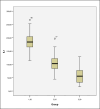Clinical, laboratory and ultrasonographic correlates of prostate calcifications in patients with chronic prostatitis/chronic pelvic pain syndrome
- PMID: 39345317
- PMCID: PMC11428367
- DOI: 10.5173/ceju.2022.222
Clinical, laboratory and ultrasonographic correlates of prostate calcifications in patients with chronic prostatitis/chronic pelvic pain syndrome
Abstract
Introduction: The research aim was to determine the role of clinical, laboratory, immunological and sonographic parameters in the development of an assessment tool for the symptomatic manifestations of prostate calcifications in chronic prostatitis/chronic pelvic pain syndrome (CP/CPPS).
Material and methods: All men underwent a transabdominal ultrasonographic examination using a grayscale B-mode and color Doppler mapping, the evaluation of the National Institutes of Health-Chronic Prostatitis Symptom Index and the Patient Health Questionnaire-9, spermogram. Vascular endothelial growth factor (VEGF), serotonin and gamma-aminobutyrate (GABA), interleukins 1β and 10 were determined in blood serum and ejaculate.
Results: This study included 102 men aged 18-45 years. Group 1 (n = 34) consisted of patients with CP/CPPS. Group 2 included patients (n = 34) with asymptomatic prostatitis. Group 3 consisted of healthy volunteers (n = 34). More severe symptoms of prostatitis and depression, as well as frequent exacerbations in patients with CP/CPPS, were associated with ultrasound evidence of prostate calcifications, and especially the twinkling artifact (Spearman's r = 0.481; р <0.001; Spearman's r = 0.437; р <0.001, respectively).The presence of prostate calcifications in both CP/CPPS and asymptomatic prostatitis was accompanied by a significantly higher concentration of pro-inflammatory cytokine IL-1β and a lower concentration of anti-inflammatory cytokine IL-10 in the ejaculate (p < 0.05 in both cases, Kolmogorov-Smirnov test). The clinical manifestations observed in patients with CP/CPPS and asymptomatic prostatitis were not correlated with the leukocyte count in the ejaculate or the levels of VEGF, GABA, and serotonin in both blood and ejaculate.
Conclusions: Twinkling artifact potentially could serve as a valuable tool for evaluating the condition of patients with CP/CPPS and prostate calcifications.
Keywords: asymptomatic prostatitis; chronic pelvic pain syndrome; gamma-aminobutyrate; interleukins; prostate calcification; serotonin; twinkling artifact; vascular endothelial growth factor.
Copyright by Polish Urological Association.
Conflict of interest statement
The authors declare no conflicts of interest.
Figures
Similar articles
-
A prospective study on association of prostatic calcifications with sexual dysfunction in men with chronic prostatitis/chronic pelvic pain syndrome (CP/CPPS).J Sex Med. 2014 Oct;11(10):2528-36. doi: 10.1111/jsm.12534. Epub 2014 Apr 16. J Sex Med. 2014. PMID: 24735240
-
Leukocytes and bacteria in men with chronic prostatitis/chronic pelvic pain syndrome compared to asymptomatic controls.J Urol. 2003 Sep;170(3):818-22. doi: 10.1097/01.ju.0000082252.49374.e9. J Urol. 2003. PMID: 12913707
-
Multidisciplinary approach to prostatitis.Arch Ital Urol Androl. 2019 Jan 18;90(4):227-248. doi: 10.4081/aiua.2018.4.227. Arch Ital Urol Androl. 2019. PMID: 30655633
-
Contemporary Management of Chronic Prostatitis/Chronic Pelvic Pain Syndrome.Eur Urol. 2016 Feb;69(2):286-97. doi: 10.1016/j.eururo.2015.08.061. Epub 2015 Sep 26. Eur Urol. 2016. PMID: 26411805 Review.
-
Chronic Prostatitis and Pelvic Pain Syndrome: Another Autoimmune Disease?Arch Immunol Ther Exp (Warsz). 2021 Sep 14;69(1):24. doi: 10.1007/s00005-021-00628-3. Arch Immunol Ther Exp (Warsz). 2021. PMID: 34523016 Review.
References
LinkOut - more resources
Full Text Sources
Miscellaneous


